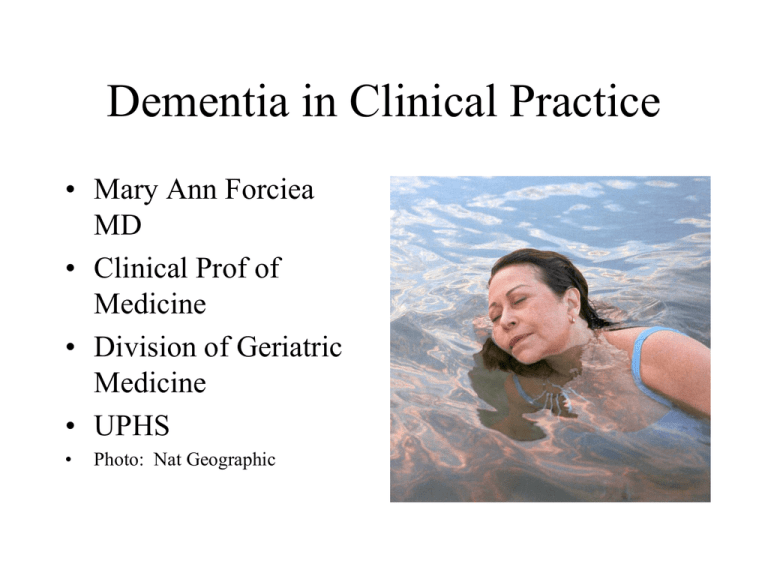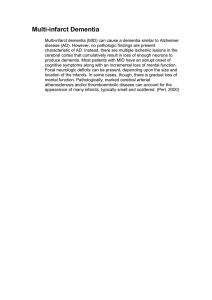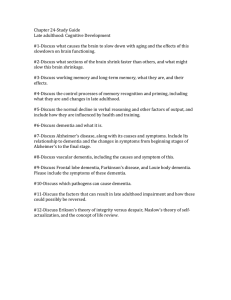Dementia in Clinical Practice • Mary Ann Forciea MD • Clinical Prof of
advertisement

Dementia in Clinical Practice • Mary Ann Forciea MD • Clinical Prof of Medicine • Division of Geriatric Medicine • UPHS • Photo: Nat Geographic Who has dementia? • 78 yr old retired librarian • Lives alone, children visit on holidays • Family concerned about ‘clutter’ in house, hygiene, unpaid bills • 68 yr old child care worker • Lives with her husband, drives, in charge of ‘house money’ • “Forgot” a child in classroom at end of day Who has dementia (2) ? • 84 yr old urology inpatient • 70 yr old homebound patient – Post op day 1: hostile – Bedbound, mute – Family caregivers – Oral intake decreasing • Attempts to strike nurse with cane • Refusing blood draw • Pulled out catheter Terms • Dementia – Chronic, progressive – Impairment in >1 “domain of cognition” • Memory, language use, executive function(judgment), attention, coordination • Mild cognitive impairment – Impairment in 1 “domain of cognition” – ? “pre-dementia” • Delirium – Short term How do we know about Brain Function? • Cell structure – Microscope (biopsy, cell culture) – CT, MRI, PET scans • Brain regions – imaging • “Domains” of cognition – Imaging – Psychological testing Cell structure: Neurons • Networks • Grey matter/white matter Brain regions • Regions have different activities Domains of cognition • • • • • • Memory Calculation Language Orientation Spatial construction Executive function (judgment) Mapping Memories Natl Geographic What is wrong in dementia? Theories Neurons: waste products, shape of cells, signaling, genetic flaws Regions: biochemistry, structure Domains: communication We don’t yet know. Clinical observations • All patients with dementias are not alike. – – – – – – Age of onset Family history Initial symptom Most troublesome symptom Rate of progression Response to treatment • Is dementia a symptom, not a disease? Dementia Subtypes • Alzheimer’s Disease • Fronto-temporal dementia (formerly Pick’s Disease) – 15% • Corticobasilar dementias • Dementia with Lewy Bodies – 20% – Distinguished from Parkinson’s Disease with dementia • Vascular disease Alzheimer’s type dementia • Gradual onset • Global impairment in cognition – Usually memory impairment predominant • Increased risk in siblings – Apo e allele risk • Slow progression (5-7 years) – Predictable course (global deterioration scores) AD - pathology • Imaging • Neuropathology – quantity and location – Senile plaques • White matter • Amyloid core – Neurofibrillary tangles • Tau protein abnormalities – Initial concentrations highest in hippocampus and temporal lobes Plaques Tangle What clinical problems do patients with Alzheimer’s Dementia Encounter? • Diagnosis • Symptom Management • End of life care Case 1 NC • 64 yr old retired OR nurse • Referred for evaluation of impaired memory – Birthdates, telephone numbers – Impaired job performance for 1-2 yrs prior – Inability to ‘balance checkbook’ • Gradual decline over 5 years • Died of pneumonia Diagnosis • • • • Largely on history Exclude other conditions Role for biomarkers in near future Staging – Mental status testing (MMSE, MOCA, MiniCog) – Functional status staging (FAST, GDR) Biomarkers for Alzheimer’s Dementia • Apo lipo protein E subtypes – Apo E-2, E-3, E-4 • 2 copies of E4 increases risk in some populations • Spinal fluid ‘tau’ protein levels • PET scans for amyloid – People with unexplained MCI – Patients with an unusual course – Early onset dementia Concerns about PET scans • How specific is an abnormal test? • May not be useful for staging – (how advanced is the disease) • Will abnormal scans result in ‘overdiagnosis’ employment or insurance implications? FAST • • • • • • • • The FAST scale has seven stages: 1 which is normal adult 2 which is normal older adult 3 which is early dementia 4 which is mild dementia 5 which is moderate dementia 6 which is moderately severe dementia 7 which is severe dementia 7a.speaking limited to 6 words or fewer in an average day b. Speech ability limited to the use of a single intelligible word in an average day c. Ambulatory ability lost (cannot walk without personal assistance). d. Ability to sit up without assistance lost (e.g., the individual will fall over if there are no lateral rests [arms] on the chair). e. Loss of the ability to smile. AD - treatment • Improve all co-existing conditions! • Specific treatments – Cholinesterase inhibitors • Donepazil, rivastigmine – Adrenergic stimulants • Memantine • Treatment of associated symptoms – Agitated behaviors • Non pharmacologic, environmental • drugs End of life issues • Should be anticipated – Advance Directives, conversations with proxies • Goals of care – – – – Nutrition Hospitalization Caregiver burdens Hospice involvement Summary • “Dementia” is a symptom complex • We are in the early stages of understanding the pathology, and discovering effective treatment • Optimal care requires advance planning, caregiver involvement, and a team of professionals





